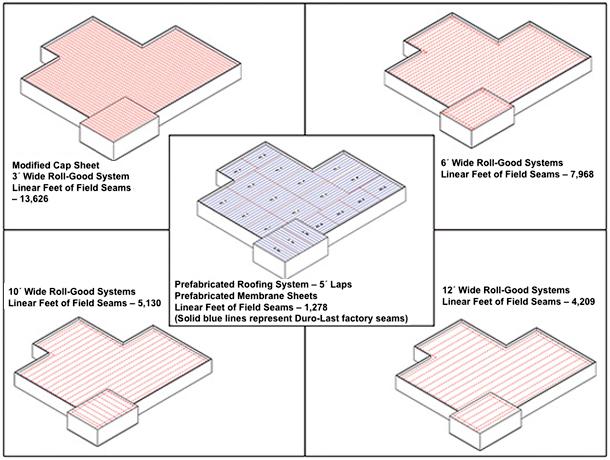Labor Shortage Solution Specifying a Factory-Made Roofing Membrane
Labor Shortage Solutions
Leaders in the construction industry have presented logical solutions to the skilled labor shortage. The Associated General Contractors of America (AGC) suggests several strategies in a report titled: “Preparing the Next Generation of Skilled Construction Workers: A Workforce Development Plan for the 21st Century.” It suggests:
- Reform and reinvigorate the Carl D. Perkins Career & Technical Education Act, which is the primary federal funding vehicle for career and educational programs;
- Encourage private funding for craft training programs;
- Improve the Workforce Investment Act;
- Make it easier for veterans to get training and to be hired;
- Encourage partnerships between registered apprenticeship programs and community colleges;
- Expand federal apprenticeship resources and collect more comprehensive data on all apprenticeship programs;
- Enact immigration reform;
- Offer community college career and technical programs for high school students for free; and
- Make it easier to establish public schools focused on career and technical education.
For the Roofing Industry, Factory-Fabricated Systems Emerge as a Labor Shortage Solution
Certainly the ideas presented by the AGC, if enacted, would bring more trained construction workers into the industry. But the timeframe is long and the outcome uncertain.
However, innovation, as it often does, may provide a quicker solution. A case in point is the growing use of prefabricated, factory-made building systems that are brought to the site and installed in a fraction of the time of site-built systems.
This solution includes prefabricated roofing membrane systems that not only install on-site with an 80 percent to 85 percent reduction in on-site seam welding, but that also solve the problem of faulty sealing around penetrations, which as we’ll see later on cause the most problems in roofing failures.
Factory-Made Building Components: A Long History
While prefab has become a buzzword in the past decade, the practice of specifying and installing prefabricated systems in buildings has quite a long history.
While specifying window systems is now normal, at one time it was common for window frames to be made and glazed on-site. Carpenters measured and cut the framing and trim members, assembled them, added glazing, and installed them into the window opening.
Cabinets were also once made primarily on-site. Eventually, factory-made cabinets, with all the quality controls inherent in such a manufacturing setting, became the norm.
Entire prefabricated houses go back at least until the 1850s, when the Loren iron house was prefabricated in England and shipped to Melbourne, Australia. It was moved to its current site in 1968.
Prefabricated homes became prevalent in England following World War II, when 3 million, or one quarter of the country’s homes, had been damaged or destroyed. The post-war years brought a great need for housing along with a shortage of skilled building labor. Plus, empty factories once engaged in the war effort were ready for new products. The homes prefabricated in these factories and then shipped to the sites were designed to last 10 to 15 years, but a few of them survive today.
Some methods of easing on-site labor needs were a hybrid of site-built and factory controls. Kit homes popular in the early 20th Century were delivered to the site with each piece of lumber cut in a factory and numbered for quick assembly on the lot. This reduced labor and eliminated cutting mistakes.
Between 1908 and 1940, Sears, Roebuck and Co. sold and shipped more than 70,000 kit homes through its Modern Homes mail order program.
In 1927, for instance, The Sears, Roebuck and Co. kit house named the Vallonia bungalow cost from $1,500 to $2,500, depending on size. Delivered to the site were the pre-cut framing lumber, wood lath, millwork, doors, windows, roofing, siding, hardware, paint, etc. Plumbing, heating, wiring, and electrical were extra.
The prefabricated method of construction may have taken over the construction industry were it not for the Levitt Brothers, who transferred the genius of Henry Ford’s assembly line for automobiles into the mass production of site-built homes. With the vast need for homes for returning veterans following World War II, the incredible efficiency of moving materials and skilled labor from house-to-house covering great tracts of land changed the home building industry. The mass produced site-built method became king.
It is, however, an incredibly inefficient and error-prone process.
“It’s incredible that we’re still building stick by stick on-site,” says Bill Robinson, president of Train2Build and a moisture management expert based in New Orleans.
Recent decades have seen the prefab method of building rising once again. The oil embargo of the 1970s kick-started the movement to build energy-efficient homes, which brought about changes to construction methods and materials. Innovations by manufacturers brought further changes to “how things are done.”
However, keeping up with current materials and methods is increasingly difficult in the great morass of non-unionized world of skilled construction labor. This can be concerning for architects, contractors, and specifiers, particularly as roofing is concerned.










